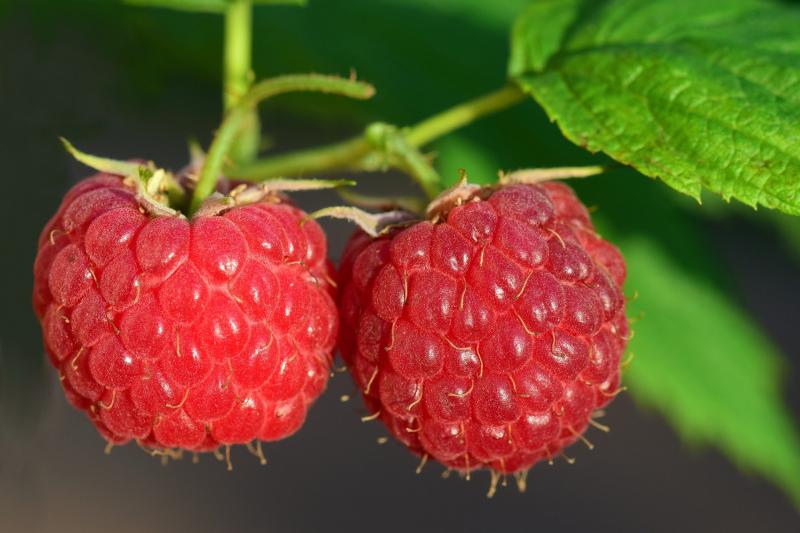Sarah Browning, Nebraska Extension Educator

Raspberries are widely grown in Nebraska and a very popular home garden fruit. They are not difficult to grow if given the proper care. Here are the best pruning, fertilization ad watering practices for your raspberries, along with a few tips on weed, insect and disease control.
Pruning
Raspberries can be divided into two groups, summer-bearing and fall-bearing. Summer-bearing cultivars produce one large crop of fruit in early summer. Fall-bearing cultivars, sometimes called "everbearing" raspberries, can be managed to produce two crops a year, with one crop in early July and the other in late August or September. But gardeners usually do better to manage fall-bearing plants for one larger fall crop. This method sacrifices the lighter and lower quality summer crop for a heavier fall crop
Summer-bearing plants
- Prune in fall after harvest is complete or in spring once the danger of frost has passed, but before bud swell. Typically this will be from about mid-April.
- Prune out any winter-killed stem tips back to heathy tissue.
- Keeping shoot development within an 18-inch band down the length of the planting row, makes pruning and harvesting easier. Dig out any plants developing outside this 18-inch row.
- Finally, remove all canes which fruited last year. These canes will not produce fruit again, instead this summer's fruit will be produced on last year's new canes.
- Thin out the remaining second-year canes
Fall or everbearing plants - To prune plants for one large fall harvest, cut all stems down to 1-2 inch height in late winter before new growth has begun. This can be done by hand or with a rotary mower, just be sure to sharpen the mower blade to make clean cuts. Remove all above ground growth. Fruit will be produced on the new growth and harvested in August or early September.
Fertilization
Raspberries are heavy feeders and perform best when provided supplemental nutrients. Composted manure can be used but should be applied in fall to reduce food safety concerns. Broadcast manure around the base of plants at a rate of 1 pound per square foot of row.
Alternatively, apply a commercial fertilizer in spring before new growth starts. Use 3-4 pounds of product per 100 feet of row, using a complete analysis product such as 10-10-10 or 12-12-12. Broadcast fertilizer uniformly beneath plants within the 18-inch row or sidedress plants by applying a band of fertilizer on each side of the row.
For smaller plants, apply ½ cup per plant of a complete fertilizer like those mentioned above.
If a soil test indicates your soil has high natural levels of phosphorus and/or potassium, then nitrogen is the only nutrient lacking. Apply 1.3-1.5 pounds of urea (46-0-0) per 100 feet of row. For organic gardener, substitute blood meal 13-0-0 or corn gluten meal 10-0-0 at 1-2 pounds per 100 feet of row.
Do not fertilize raspberries in late spring or summer; applications at these times encourage succulent growth which is more easily infected by diseases such as anthracnose. Do not fertilize in late summer; tender new growth developing in response to late season fertilization is susceptible to winter damage.
Watering
Raspberries particularly need irrigation during bloom and harvest. Water plants early in the day; installing a drip or trickle system to avoid wetting the foliage is a great idea. These systems place the water onto the root zone around the plants so they receive the moisture without encouraging weeds or wasting water. Apply 1.5-2 inches of water once a week during the fruiting season if rainfall is inadequate. Irrigate plants once every two to three weeks during the rest of the season, when rainfall is less than 1-inch per week.
Weed Control
In spring and summer, maintain a 2-inch layer of mulch beneath plants to aid in weed control and conserve soil moisture. Mulching reduces the need for weed control by hoeing and increases yield. Many different types of mulch materials can be used, including wood chips, lawn clippings (no herbicides applied to lawn), shredded leaves, chopped corn or alfalfa stalks, sawdust or straw. Topdress mulch as needed each year to maintain a 2-inch layer. Too much mulch can retain too much water and cause root disease problems.
Hand hoeing is one of the most practical methods of weed control in the raspberry planting. Keep about a 3-foot wide strip of ground cultivated around the plants. Cultivate frequently in spring and summer to kill young weeds and prevent them from getting out of control. To prevent injury to the raspberry roots, don't cultivate any deeper than 2-3 inches into the soil.
Organic preemergent products, including corn gluten meal, can be broadcast beneath plants and will kill weed seeds as they germinate. Corn gluten meal will not harm the raspberry plants. Look for it in products such as Preen Vegetable Garden Natural Weed Preventer.
Pest Control
Pruning is an important aspect of disease control,
For pictures and control recommendations on common raspberry insects and diseases, check out the publications below.
- Growing Raspberries in the Home Garden, University of Minnesota Extension.
- Home Fruit Spray Schedules for the Homeowner, University of Missouri Extension.
Getting your raspberries off to a good start in spring, will help ensure many delicious berries to come later this summer.
Search Our Archive
Associated Video
Pruning Bramble
Nebraska Extension Landscape Horticulture Specialist Kim Todd shows how to prune blackberry brambles.